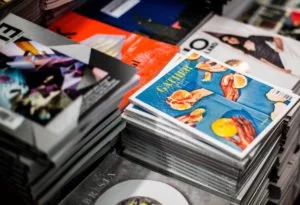Laser printer vs. inkjet printer?
It’s one of the most basic and most essential comparisons when it comes to shopping for a new printer. If you’re in the market, you’re probably wondering which of the two to purchase – whether it’s for home and personal use or business applications.
In a previous post, we discussed digital printing vs offset. As per CMYK tradition, we’re here again to compare the differences between two specific print technologies, this time zoning in on the intricacies of laser printing vs. inkjet.
Laser Printer vs. Inkjet Printer: The Basics
The most basic definition of printing is the same for both laser printing and inkjet – putting images and text onto paper. However, the two digital printing technologies achieve results in different ways.
Inkjet printing relies on liquid ink which is deposited as microdroplets onto the page through a print head. These droplets are ionized, which means they are directed by magnetic plates in the ink’s path. As the paper is fed through a set of rollers, the print head precisely sprays the microdroplets by moving back and forth on the page. If we talk about laser printing vs. inkjet’s printing process, the latter is much simpler but also easily leads to smudging.
Depending on whether the ink is dye or pigment-based, the ink may change the paper’s color. It can also simply dry as a deposit on the paper’s surface.
What about laser printing?
Laser printing is a digital printing method that relies on toner, which is in powder form. The “laser” in this method is used to generate an electrostatic charge that transfers the toner onto the paper. The toner is then bonded to the page’s surface using heat. When it comes to laser printing vs. inkjet, laser printing makes quicker prints that are smudge and fade-resistant.

Inkjet vs Laser for Photo Printing
If you’re looking to print photos on different types of paper, both laser printers and inkjet printers have their individual pros and cons.
If you use photo coated paper, there’s no question that inkjet machines are more suitable for the job. You will see smoother color transitions and deeper blacks. If you also get your hands on semi-professional inkjet printers, the color effects of oranges and reds can be dramatic on high-quality archival paper. That’s why many photographers opt for inkjet printing instead of laser. Inkjet printers are particularly great for art reproduction as they offer a great range of colors. However, you will be looking at a costlier process due to the quality and range of colors available.
But if you’re looking to print colored images or text in volume on cards or plain paper, laser printing is the ideal choice. For instance, brochures, posters, and other point of sale materials are best printed through laser printers. Not only are they able to print high-quality images at a much faster pace, but they operate at a lower cost too. But keep in mind that you won’t be able to achieve the same art reproduction finish as opposed to inkjet printing.
Are Inkjet Printers Cheaper to Run than Laser?
Now that we’ve discussed the major differences between laser printing vs. inkjet, it’s time to talk about their cost.
After all, when it comes to buying a printer, the cost is always a big factor in the decision. Sure, you want specific features, but you have to take note of your budget too.
If we talk about upfront costs, inkjet printers tend to be much cheaper than laser printers. As the technology is less complex, it’s less costly to manufacture. However, even if an inkjet printer costs less to buy, you end up paying more in the long run because buying a full set of new ink cartridges is expensive. Some manufacturers even sell inkjet printers at a loss because they know they’ll get a big profit from ink sales.
On the other hand, laser printers are more expensive to buy but toner is less expensive on a per-page basis. This is because toner comes in powder form, making it easier to shop, store, and use.
Laser Printer vs Inkjet Cost Per Page
Inkjet printers vary in the cost per page but they tend to be more expensive than the per page basis for laser printers. This is because printer ink is designed to provide precise flow rates, to blend and bleed with expected consistency, and to dry within seconds – all while providing colors that look accurate.
Toner cartridges are more expensive upfront but they far exceed the print yields provided by inkjet printers. Toner also stores better in the long run. If kept properly, ink cartridges can be stored for months but the liquids can dry out. Since toner starts off as a powder, you won’t need to worry about it losing its liquidity and functionality.
In short, laser printers offer a cheaper printing cost per page even if toner is more expensive upfront.
Which is Better: Inkjet or Laser Printer?
Alright, let’s arrive at a conclusion on our laser printing vs inkjet debate. In other words, let’s talk about print quality. Which one’s better over the other?
Inkjet printers, with their dye and pigment-based inks, are better at handling color, specifically for photos and images. These are more likely to involve subtle color shades. The nature of liquid ink means that those blends and mixtures are easier to reproduce on an inkjet printer rather than on a laser machine.
Laser printers are not always equipped to handle photo printing. Instead, they rely on halftone dots to create certain colors on paper. Even laser printers capable of handling higher-quality color for photo printing require specialized photo paper that’s laser-printer-ready. This makes laser printing much less convenient compared to using regular photo paper on an inkjet machine.
On the bright side, laser printers tend to be better for printing text as they offer crisp and clear letterforms unmatched by most inkjet printers. Inkjet printing often bleeds slightly. While the prints are legible, the individual letters are not as sharp in detail, especially upon close examination.
Printer ink also has a tendency to smear, and since inkjet prints continue to dry after printing, inkjet users need to anticipate the possibility of smudged documents. On the contrary, laser printers use a heat-transfer method so the prints are set and smudge-proof when they come out of the printer.
In a nutshell, asking “Which is better, inkjet or laser printer?” won’t help you arrive at an objective answer. It truly depends on your desired output. Inkjets are better for printing photos and laser printers are more suited for text documents, especially at high volumes. So, for instance, if you’re currently learning how to print stickers, it’s best to use an inkjet printer if you’re going to be producing stickers with images or photos.
Laser Printing vs Inkjet Printing: Key Takeaway
As previously stated, deciding between a laser printer vs inkjet printer really boils down to what you want to use the machine for. Some people print more photos than text documents, while others print reams of text but rarely need photos.
Generally, here are the advantages of inkjet printers:
- Great for image-heavy documents and photos as they do a better job of blending smooth colors.
- Have a low start-up cost and ink cartridges are cheaper too.
- Can print onto many types of substrate, including textured stationery, glossy photo paper, and even some fabrics.
- Little to no warm-up time needed before printing.
- Tend to be lighter, smaller, and easier to maintain.
Laser printers, on the other hand, have the following pros:
- Print faster than inkjet printers, making high-volume printing jobs much more efficient.
- Produce perfect sharp black text and handle fine lines and small fonts better.
- Much suitable for high-volume print jobs that are mostly text with occasional graphics.
- Laser printer vs inkjet cost per page is lower as toner cartridges print more sheets relative to their cost.
To sum it all up, inkjet printing is generally better for the occasional printer and for those who print images and photos. Laser printing, on the other hand, offers the most cost-effective way to print text-heavy pages. It’s faster too, offering smudge-free pages in seconds that are crisp and easy to read.
For more in-depth articles about different printing technologies, check out our blog!



